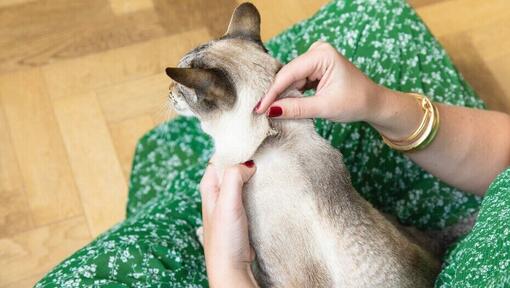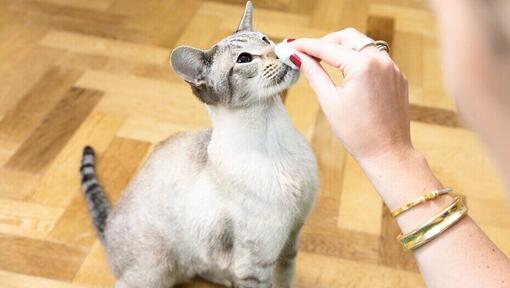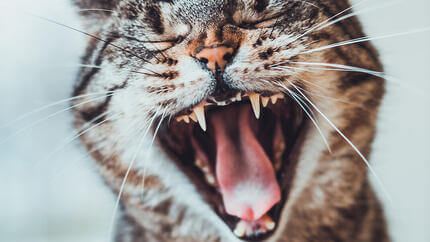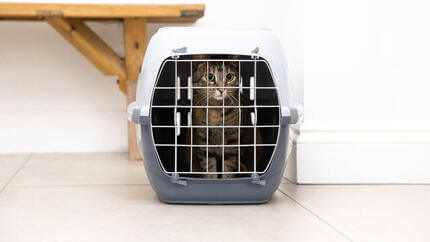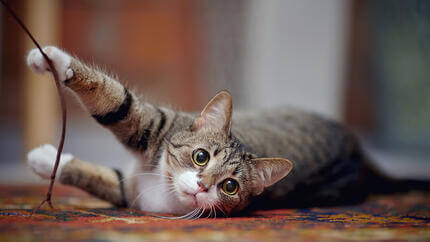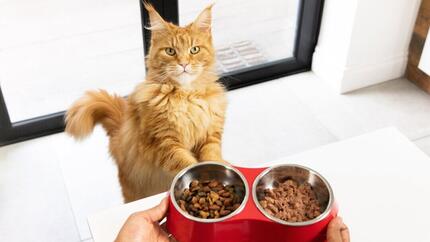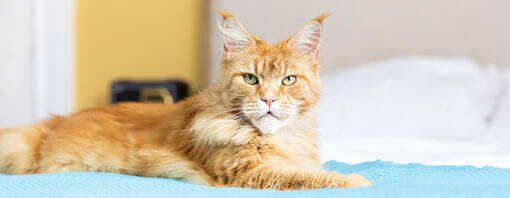
As a loving pet owner, you’re bound to want the absolute best for your cat, and this all starts with making sure that they are as happy and healthy as possible.
Health checklist
Every month you should “play vet” and conduct a careful check-up on your cat to make sure that all is well. By following our checklist, you have the opportunity to spot any unusual signs early on, meaning that you can seek treatment as soon as possible, if necessary. Not only does this help you keep your cat in tip-top condition, but also allows you to spend more hands-on quality time with your feline friend.
Body condition
When you’re caring for cats, you should regularly check their body condition score. When you run your hands over your cat, you should be able to feel and – depending on their breed or coat length – sometimes see their ribs easily, with only a slight covering of fat.
They should have a well-defined hourglass waist when viewed from above, and they should have a very slight pad of fat on their tummy.
Ears
Cat ears are very delicate and sensitive, so should be treated with care. Their ears should always be clean, with no thick or waxy discharge, and there shouldn’t be any redness, itchiness or offensive smells. If your cat has thin hair or white-tipped ears, consider massaging in a smear of sunscreen to protect against sunburn (which can lead to skin cancer) on hot or sunny days.
If your cat starts to hold their head to one side, rubs their face on surfaces more than usual or is always shaking their head, take them to the vet for a thorough ear exam and general cat health check. Never probe your cat’s ears yourself or insert anything inside – this could potentially cause further damage, and you don’t want that.
For more in-depth information on how to care for your cat’s ears, see our page on cat ear problems.
Eyes
Your cat’s eyes should be bright and clear with no signs of runniness, redness or soreness. Your pet shouldn’t be squinting or shying away from the light, and if they start bumping into objects all of a sudden, take them to the vet for a check-up.
Nose
Your cat’s nose should be soft and slightly damp to the touch. Crusting, bleeding, discharge and excess sneezing are all signs that something’s not quite right, so take them to the vet for a health check.
This is particularly important if their eyes are also a little runny, as cats are susceptible to the flu.
Mouth
Cats with bad breath make for less than pleasant company, but smelly breath can also indicate an underlying digestive or kidney problem. More commonly, though, it’s a sign of bacterial overgrowth or plaque on their teeth and gums, which if left untreated can lead to tooth decay and gum disease, and sometimes organ problems.
Teeth should be white or cream with no excess tartar, which looks thick and brown. Gums should be healthy pink (or black depending on your cat’s skin pigmentation), and certainly not red, swollen or bleeding. Keep an eye out for bad breath, excess salivation, a reluctance to eat, clawing at the mouth and dropping food – these are all signs that something’s wrong. Ask your vet to brush your cat’s teeth every time you visit, but ideally you’ll brush your cat’s teeth twice a day with a special cat toothpaste. Your vet can recommend one.
Skin and coat
Depending on your cat’s skin pigmentation, their skin will be pink or black, and shouldn’t show any signs of crusting, itching, scaling, black or white spots, infection or inflammation. Their coat should be thick (although some breeds will have thinner coats than others) and shiny, with no broken hair, bald patches, dandruff or fleas. Cats can also suffer from cat acne – it can be tempting for you or your cat to pick at, but resist and speak to your vet instead.
Your cat will shed their hair all year round, but usually more in summer and autumn, so it’s helpful to get your cat into the habit of regular grooming from an early age – and to have a good vacuum cleaner! Fleas and ticks can be a common problem for cats – our page on treating cat fleas and ticks should help you to keep pesky parasites at bay.
Aside from bugs, there can be lots of other factors that can affect your cat’s skin and coat. See our page on cat skin problems and hair loss in cats for in-depth information.
Nails
Your cat’s nails can be black or white, and should be smooth – rough or flaky nails might require a visit to the vet. To check your cat’s nails, gently squeeze on the pads of their paws so the nails fully emerge. Don’t forget to check their dew-claws, which can be found on the inside of their leg, just above the paw. Some cats have them on their front legs only, some on the front and the back, and some don’t have any at all!
You should give your cat’s paws a once-over while you’re looking at their nails, to make sure they’re clean and healthy. If you have an outdoor cat you should clean their paws regularly, especially in winter, as antifreeze can be toxic to cats if they walk in it and then eat it as they groom themselves.
Digestion
Cats can be fussy eaters – this is because being sick takes a lot of effort for them, so they will try to avoid it at all costs! It’s quite normal for cats to occasionally regurgitate food or cough up a hairball, but generally there shouldn’t be any vomiting or reluctance to eat.
If you’re caring for cats, keep an eye on their appetite and be aware of what you – and everyone else in the family – feeds them. If you make any dietary changes, do it gradually over the course of 7-10 days, and pay attention to any changes in your cat’s poo. It should be a consistent brown colour with a solid texture, with no blood or mucus. Changes in appetite or digestion can be perfectly normal, but never assume your cat is simply being fussy – talk to your vet to be sure.
Respiration
Cats don’t open-mouth breathe like dogs do, so any sign of panting, wheezing or coughing should be investigated by a vet as soon as possible.
Thirst
Cats are clever creatures and they’ll find ways to quench their thirst from some unusual sources, such as a dripping tap or even a puddle. So don’t worry too much if your otherwise healthy cat doesn’t appear to drink that much.
However regardless of whether your cat is an indoor or outdoor cat, always make sure you have a bowl of fresh, clean water available for them. If your cat suddenly becomes very thirsty or starts drinking more than usual without extra exercise, it could be a sign of an underlying medical problem, and you should talk to your vet.
Attitude
Your cat’s attitude can tell you a lot! Cat behaviour is often an indicator of how he or she is feeling, so if they’re poorly you’ll probably see it in their body language. For example, if your cat is sleeping more than usual, or they seem quieter and less playful, it might mean they’re under the weather.
Poorly cats can also shy away from human contact, start urinating in unusual locations and sometimes seem unusually aggressive for no reason. Cats are very good at hiding illness though, so be mindful of any unusual changes and speak to your vet if you have any concerns.
By following this checklist, you should be able to keep a close eye on your cat to make sure they’re in tip-top health so that you and your pet can be as happy as possible together.


